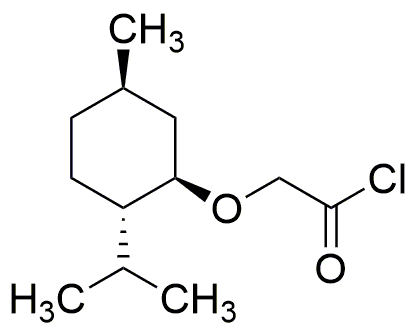(-)-Menthoxyacetyl chloride is widely utilized in research focused on
- Synthesis of Pharmaceuticals: This compound serves as a key intermediate in the synthesis of various pharmaceutical agents, particularly in the development of analgesics and anti-inflammatory drugs. Its unique structure allows for the modification of drug properties, enhancing efficacy.
- Flavor and Fragrance Industry: It is used in the formulation of flavoring agents and fragrances due to its pleasant minty aroma. This application is particularly valuable in creating appealing products in the food and cosmetics sectors.
- Organic Synthesis: Researchers leverage its reactivity in organic synthesis to create complex molecules. Its ability to participate in acylation reactions makes it a versatile building block in chemical manufacturing.
- Research in Chemical Biology: The compound is employed in chemical biology studies to modify biomolecules, aiding in the understanding of biological processes and the development of new therapeutic strategies.
- Polymer Chemistry: It finds application in the production of specialty polymers, where it acts as a modifying agent to enhance the properties of polymeric materials, making them suitable for specific industrial applications.
Información general
Propiedades
Seguridad y normativas
Aplicaciones
(-)-Menthoxyacetyl chloride is widely utilized in research focused on
- Synthesis of Pharmaceuticals: This compound serves as a key intermediate in the synthesis of various pharmaceutical agents, particularly in the development of analgesics and anti-inflammatory drugs. Its unique structure allows for the modification of drug properties, enhancing efficacy.
- Flavor and Fragrance Industry: It is used in the formulation of flavoring agents and fragrances due to its pleasant minty aroma. This application is particularly valuable in creating appealing products in the food and cosmetics sectors.
- Organic Synthesis: Researchers leverage its reactivity in organic synthesis to create complex molecules. Its ability to participate in acylation reactions makes it a versatile building block in chemical manufacturing.
- Research in Chemical Biology: The compound is employed in chemical biology studies to modify biomolecules, aiding in the understanding of biological processes and the development of new therapeutic strategies.
- Polymer Chemistry: It finds application in the production of specialty polymers, where it acts as a modifying agent to enhance the properties of polymeric materials, making them suitable for specific industrial applications.
Documentos
Hojas de datos de seguridad (HDS)
La SDS proporciona información de seguridad completa sobre la manipulación, el almacenamiento y la eliminación del producto.
Especificación del producto (PS)
La PS proporciona un desglose completo de las propiedades del producto, incluida la composición química, el estado físico, la pureza y los requisitos de almacenamiento. También detalla los rangos de calidad aceptables y las aplicaciones previstas del producto.
Certificados de análisis (COA)
Busque certificados de análisis (COA) ingresando el número de lote del producto. Los números de lote y de partida se pueden encontrar en la etiqueta de un producto después de las palabras "Lote" o "Lote".
Número de catálogo
Número de lote/lote
Certificados de origen (COO)
Este certificado de origen confirma el país en el que se fabricó el producto y también detalla los materiales y componentes utilizados en él y si se deriva de fuentes naturales, sintéticas u otras fuentes específicas. Este certificado puede ser necesario para cumplir con las normativas aduaneras, comerciales y regulatorias.
Número de catálogo
Número de lote/lote
Hojas de datos de seguridad (HDS)
La SDS proporciona información de seguridad completa sobre la manipulación, el almacenamiento y la eliminación del producto.
DownloadEspecificación del producto (PS)
La PS proporciona un desglose completo de las propiedades del producto, incluida la composición química, el estado físico, la pureza y los requisitos de almacenamiento. También detalla los rangos de calidad aceptables y las aplicaciones previstas del producto.
DownloadCertificados de análisis (COA)
Busque certificados de análisis (COA) ingresando el número de lote del producto. Los números de lote y de partida se pueden encontrar en la etiqueta de un producto después de las palabras "Lote" o "Lote".
Número de catálogo
Número de lote/lote
Certificados de origen (COO)
Este certificado de origen confirma el país en el que se fabricó el producto y también detalla los materiales y componentes utilizados en él y si se deriva de fuentes naturales, sintéticas u otras fuentes específicas. Este certificado puede ser necesario para cumplir con las normativas aduaneras, comerciales y regulatorias.


